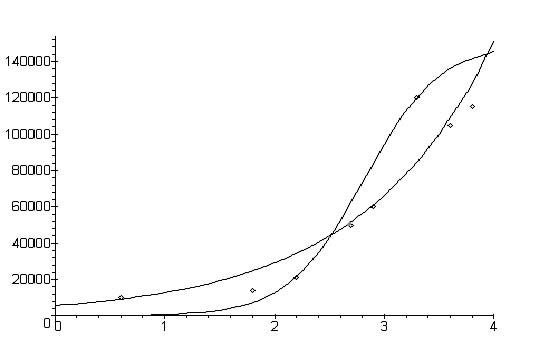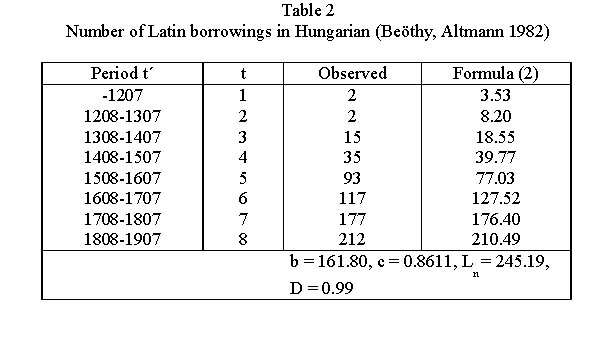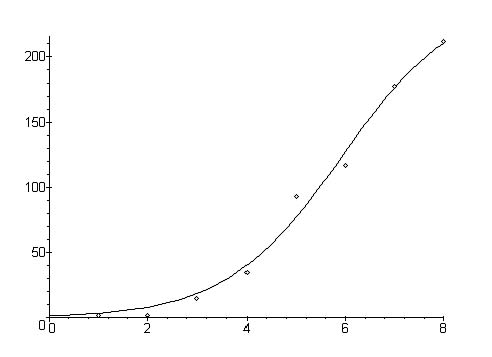Lexicon growth
1. Problem and history
Every lexicon grows. New lexemes are added by creation, by combining of existing elements and by borrowing. The problem is to find how the whole or its special parts change.
Historically, this research goes back to Piotrovskij, Bektaev, Piotrovskaja (1977), Beöthy, Altmann (1982) and Tuldava (1984, 1988). A lot of testing has been performed in Best, Kohlhase (1983).
Best (2003a:117) has shown that in some cases lexicon reduction abides by the same law.
2. Hypothesis
The growth of the vocabulary is a time-dependent process.
“Growth” means the increase of vocabulary in terms of numbers of items in general or of special items like borrowings or terminology. “Vocabulary” can be the vocabulary of a child, that of a field, that of the whole language, etc.
3. Derivation
3.1. The Piotrovskij et al. approach (1977), also Tuldava (1984)
The relative rate of change of the vocabulary size (L) in a time period t is constant, or the rate of change of the vocabulary is proportional to its actual state, i.e.

yielding
(1) , t = time period,
, t = time period,
 = vocabulary size at the end of t
= vocabulary size at the end of t
 = vocabulary size at the beginning of the measurement
= vocabulary size at the beginning of the measurement
Though this approach is realistic, it cannot be effectively tested beacause (a) there are no complete dictionaries encompassing all fields of human activity, (b) personal vocabularies cannot be infinite.
3.2. The Beöthy – Altmann – Tuldava approach
Beöthy, Altmann (1982) used this approach to borrowings, Tuldava (1984) to the increase of the vocabulary of literary language. The rate of change of the vocabulary size is proportional to its present state ( ) and to the difference to the limiting boundary (Ln) (the limiting boundary can be the capacity of the memory or that of printed dictionaries), i.e.
) and to the difference to the limiting boundary (Ln) (the limiting boundary can be the capacity of the memory or that of printed dictionaries), i.e.

yielding
(2)
where a nd b are parameters. This is the logistic curve used also with language change ( )
)
Example: The growth of the Estonian literary lexicon
Tuldava (1998: 140) shows the increase of the Estonian literary lexicon in the 17th to 20th century based on normative dictionaries. He transforms t = (t´- 1600)/100 (see Table 1 and Fig. 1).
Evidently, formula (2) yields somewhat better results (in this case) and is more realistic.
Example: Borrowing of Latin words in Hungarian
Beöthy and Altmann (1982) show the extent of borrowing of Latin words in Hungarian in Table 2 and Fig. 2.
The fit is almost perfect.
4. Authors: G. Altmann, K.-H. Best
5. References
Beöthy, E., Altmann, G. (1982). Das Piotrowski-Gesetz und der Lehnwortschatz. Zs. für Sprachwissenschaft 1, 171-178.
Best, K.-H. (2001). Ein Beitrag zur Fremdwortdiskussion. In: S. J. Schierholz, E. Fobbe, S. Goes, R. Knirsch (eds.), Die deutsche Sprache in der Gegenwart. Festschrift f. Dieter Cherubim zum 60. Geburtstag: 263-270. Frankfurt u.a.: Lang.
Best, K.-H. (2001a). Wo kommen die deutschen Fremdwörter her? Göttinger Beiträge zur Sprachwissenschaft 5, 6-20.
Best, K.-H. (2001b). Der Zuwachs der Wörter auf -ical im Deutschen. Glottometrics 2, 11-16.
Best, K.H. (2003a). Quantitative Linguistik. Eine Annäherung. 2., überarbeitete und erweiterte Auflage. Göttingen: Peust & Gutschmidt.
Best, K.-H. (2003b). Anglizismen - quantitativ. Göttinger Beiträge zur Sprachwissenschaft 8, 7-23.
Best, K.-H. (2003c). Slawische Entlehnungen im Deutschen. In: S. Kempgen, U. Schweier, T. Berger (eds.), Rusistika × Slavistika × Lingvistika. Festschrift für Werner Lehfeldt: 464-473 München: Vlg. Otto Sagner.
Best, K.-H. (2003d). Spracherwerb, Sprachwandel und Wortschatzwachstum in Texten. Zur Reichweite des Piotrowski-Gesetzes. Glottometrics 6, 9-34.
Best, K.-H. (2003e). Zur Entwicklung von Wortschatz und Redefähigkeit bei Kindern. Göttinger Beiträge zur Sprachwissenschaft 9, 7-20.
Best, K.-H. (2003f). Wie verläuft Sprachwandel? Naukovij Visnik Černivec´kogo Univeristetu 155, 86-94.
Best, K.-H. (2004). Das Fremdwort aus der Sicht der Quantitativen Linguistik. In: S. Wichter, O. Stenschke, M. Tants (eds.), Theorie, Steuerung und Medien des Wissenstransfers: 89-99. Frankfurt: Lang.
Best, K.-H. (2004a). Zur Ausbreitung von Wörtern arabischer Herkunft im Deutschen. Glottometrics 8, 74-77.
Best, K.-H., Altmann, G. (1986). Untersuchungen zur Gesetzmäßigkeit von Entlehnungsprozessen im Deutschen. Folia Linguistica Historica 31-41.
Best, K.-H., Kohlhase, J. (eds.) (1983). Exakte Sprachwandelforschung. Göttingen, Herodot.
Hentschel, G. (1995). Zur ‚Seuche‘ des deutschen Lehnwortes im Polnischen und zu den ‚Selbstheilungskräften‘ dagegen. In: A. Bochnakowa et S. Wid»ak (eds.), Munus amicitiae. Studia Linguistica in honorem Witoldi Mańczak k septuagenarii: 69-78. Universitas Iagellonica, Ser. Varia CCCLVI, Cracowiae.
Kempgen, S. (1990). Zur Modellierung von Lehnbeziehungen. In: W. Breu (Hrsg.), Slavistische Linguistik 1989: 99-116. München: Sagner.
Körner, H. (2001). Der Zuwachs der Wörter auf -ion im Deutschen. Glottometrics 2, 82-86.
Körner, H. (2003). Wortschatzentwicklung im Deutschen. Untersuchung zur Überprüfung des Piotrowski-Gesetzes. Göttingen: Magisterarbeit.
Körner, H. (2004). Zur Entwicklung des deutschen (Lehn)Wortschatzes. Glottometrics 7, 25-49.
Lazard, G. (1965). Les empruntes arabes dans la prose persane du X-e au XII-e siècle : aperçu statistique. Revue de l´Ecole National des language orientales 2, 53-67.
Müller-Hasemann, W. (1983). Das Eindringen englischer Wörter ins Deutsche ab 1945. In: Best, Kohlhase (eds.) 1983: 143-160.
Piotrovskij, R.G., Bektaev, K.B., Piotrovskaja, A.A. (1977). Matematičeskaja lingvistika. Moskva: Nauka.
Piotrowski, R.G., Bektaev, K.B., Piotrovskaja, A.A. (1985). Mathematische Linguistik. Bochum: Brockmeyer.
Tuldava, J. (1987). Problemy i metody kvantitativno-sistemnogo issledovanija leksiki. Tallinn: Valgus.
Tuldava, J. (1998). Probleme und Methoden der quantitativ-systemischen Lexikologie. Trier: WVT.
Wagner, K.R., Altmann, G., Köhler, R. (1986). Zum Gesamtwortschatz der Kinder. In: Wagner, K.R. (ed.), Wortschatz-Erwerb: 128-142. Bern: Lang.



